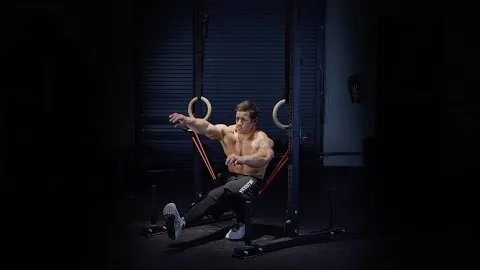
The banded pistol squat exercise is a fantastic lower body movement that targets the quads, hamstrings, glutes, and core muscles. This exercise involves balancing on one leg while descending into a deep squat position. Adding a resistance band to the movement increases the intensity and engages more muscles, ultimately leading to greater strength gains and improved stability.
Strengthens the Lower Body: The banded pistol squat primarily works the muscles of the lower body, including the quadriceps, hamstrings, and glutes. These muscles are responsible for everyday movements such as walking, climbing stairs, and squatting down. Strengthening them can improve overall athleticism and decrease the risk of injury.
Improves Balance and Stability: One-legged movements like the pistol squat challenge the body's balance and stability. By performing this exercise regularly, you can enhance your proprioception and dynamic stability, which will carry over to other activities like running, jumping, and playing sports.
Increases Core Strength: Balancing on one leg while performing the pistol squat requires substantial core strength. The core muscles, including the abs, obliques, and lower back, work synergistically to maintain balance and stability throughout the movement. Strengthening these muscles can improve posture and provide a solid foundation for other exercises and daily activities.
Enhances Flexibility: As you descend into the pistol squat, your hip flexors, hamstrings, and calf muscles are stretched. Regularly performing this exercise can increase your lower body flexibility, making movements like squatting and lunging easier and more efficient.
Engages Stabilizer Muscles: The banded pistol squat places a significant demand on the stabilizer muscles of the ankle, knee, and hip joints. By incorporating resistance bands into the exercise, the challenge is elevated even further. Strengthening these stabilizer muscles can help prevent common lower body injuries and improve overall joint health.
Begin by attaching a resistance band securely to a sturdy anchor point, such as a squat rack or door anchor.
Step inside the resistance band, placing it just above your knees.
Stand tall with your feet hip-width apart, engaging your core muscles.
Lift one leg slightly off the ground while keeping the other foot planted firmly on the floor.
Slowly lower yourself down by bending your knee and hip, while keeping the elevated leg extended in front of you.
Lower yourself as far as you can while maintaining control and balance.
Push through the heel of your grounded foot and engage your leg and glute muscles to push yourself back up to the starting position.
Repeat the movement for the desired number of repetitions on one leg before switching sides.
Keep your chest lifted and your back straight throughout the entire movement to maintain proper posture.
Focus on lowering yourself slowly and with control, rather than rushing through the descent.
Engage your core and hip muscles to help stabilize your body as you perform the exercise.
Avoid allowing your knee to cave inward; instead, track it over your second toe to maintain proper alignment.
Once you have mastered the basic banded pistol squat, you can make the exercise more challenging by incorporating the following variations and progressions:
Weighted Pistol Squat: Hold a dumbbell or kettlebell in your hands, keeping it close to your chest as you perform the movement. This added resistance will increase the difficulty and further strengthen your lower body muscles.
Elevated Pistol Squat: Perform the pistol squat with your grounded foot placed on an elevated surface, such as a step or box. This variation increases the range of motion and requires more strength and flexibility.
Pistol Squat Jump: After performing a pistol squat, explosively jump up into the air, switching legs mid-air and landing softly on the opposite leg. This plyometric variation adds an element of power and cardiovascular conditioning to the exercise.
Incorporating banded pistol squats into your lower body strength training routine can yield numerous benefits in terms of strength, stability, and flexibility. This exercise targets multiple muscle groups simultaneously and challenges your balance and coordination. By progressively increasing the difficulty of the movement, you can continue to challenge your body and reap the rewards of improved performance and overall fitness. So, grab a resistance band, give the banded pistol squat a try, and start reaping the rewards for your lower body strength training journey.
If you're looking for a gym, fitness club or yoga studio, you've come to the right place.
You can find information about gyms in your area. Browse catalog of gyms and find gyms with classes which are you looking for.
On gym page you can find simple information like address, phone or website. You can find list of available classes. You can check availability of personal training or small group classes. On place page you can also see information about open hours.
You can find gyms near you with amenities, courts, studios and equipments.
Use our map to find gym at your city or district.
In Gym Navigator you can find list of exercises with movies for many body parts.
You can browse exercises catalog and find exercises the best of you.
You can also find exercises grouped into workout plans, which you can use to improve you body. Each routine show you exercises one by one and give you possibility to count you progress and count down rest time.